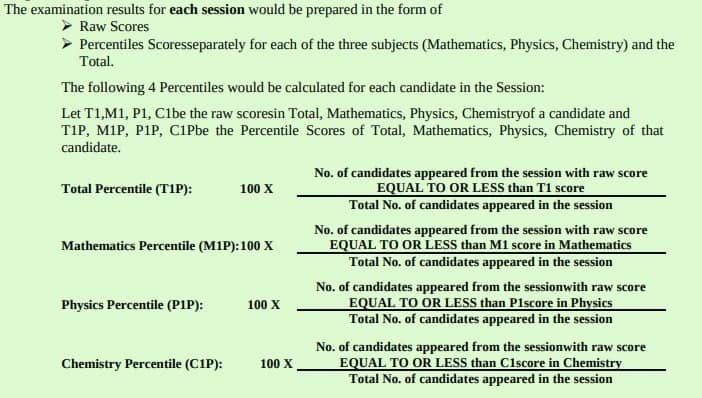Amity University-Noida B.Tech Admissions 2026
Among top 100 Universities Globally in the Times Higher Education (THE) Interdisciplinary Science Rankings 2026
JEE Main Percentile Calculator 2026 - The National Testing Agency applied a specific formula to determine's the JEE Main 2026 percentile. Using this calculator, students can estimate their percentile based on their scores in the JEE Mains exam. Candidates must check the details of the JEE Main 2026 percentile calculator provided on this page. By using this percentile, candidates can assess their percentile and determine their standing among all the other candidates who appeared for the JEE Main 2026 exam. Please note that the JEE Main rank list 2026 will be prepared based on a candidate's percentile, not just thier raw scores. The complete procedure for using the JEE Main percentile calculator 2026 is explained in this article in a simplified manner.
Must Check: JEE Main 2026 Rank Predictor | JEE Main 2026 College Predictor
The least and most opted courses by candidates at IIT Delhi in the last two years are as follows.
Courses | 2025 | 2024 |
Chemical Engineering | 9920 | 9219 |
Biotechnology and Biochemical Engineering | 9930 | 9563 |
Civil Engineering | 16128 | 15122 |
Chemical Engineering | 16591 | 15805 |
| 5-year Computer Science and Engineering | 17825 | 16188 |
Electrical engineering (power and automation) | 17722 | 16226 |
Maths and computing | 20087 | 18760 |
Mechanical Engineering | 20357 | 19035 |
Computer Science Engineering | 27697 | 25064 |
Electrical Engineering | 23503 | 21855 |
JEE Main 2026: IIT Delhi’s CSE, EE most opted; last 2 years' closing ranks for all categories
This Story also Contains

The National Testing Agency calculates the scores of JEE Main 2026 for percentile for individual subjects separately (Physics, Chemistry, and Mathematics) as well as in the combined format using the normalization formula as shown below.
| Particulars | Details |
|---|---|
Total Percentile (T1P) | (100 x No. of candidates from the session with a raw score equal to or less than T1 score) / Total No. of candidates who appeared in the session |
Mathematics Percentile (M1P) | (100 x No. of candidates appeared from the session with a raw score equal to or less than than M1 score in Mathematics) / Total No. of candidates who appeared in the session |
Chemistry Percentile (C1P): | (100 x No. of candidates appeared from the session with a raw score equal to or less than C1 score in Chemistry) / Total No. of candidates who appeared in the session |
Physics Percentile (P1P) | (100 x No. of candidates appeared from the session with raw score equal to or less than P1 score in Physics) / Total No. of candidates who appeared in the session |

NTA is expected to release a official notice consisting of a table to classify the range of percentages as secured by students who appeared in the JEE Main 2026 paper. Students will be able to check their official percentile as per their appeared shift from the NTA press release when uploaded.
NTA calculates the JEE Main 2026 percentile using the process of normalization of marks. There is a certain number of marks against which the percentile score is allotted, which in turn can be called the JEE Main 2026 marks vs percentile. Aspirants may refer to the table below to know the expected range of marks for which a certain percentile is allotted to the respective candidates.
| JEE Main Marks | JEE Main Percentile |
|---|---|
300-280 | 100-99.99745 |
279-260 | 99.99417-99.98881 |
259-240 | 99.97720-99.94664 |
239-220 | 99.91595-99.90111 |
219-200 | 99.80777 – 99.79506 |
199-170 | 99.62402-99.45693 |
169-140 | 99.06985-98.73238 |
139-110 | 97.94047-97.14293 |
109-80 | 95.64338-93.47123 |
79-50 | 90.41098-82.01606 |
49-20 | 73.08140-37.69452 |
19-0 | 20.95045-0.84351 |
NTA will release the JEE Main tie-breaking rule 2026. Candidates can check the JEE Main 2026 tie-breaking policy below. The tie-breaking rules apply when two candidates obtain the same JEE Main scores. However, to allot the JEE Main ranks, the authorities follow the tie-breaking policy JEE Main 2026. The tie-breaking for JEE Main 2026 will apply in the following order.
The tie between candidates obtaining the same Total NTA scores will be resolved in the following manner:
In case two candidates obtain the same marks in the JEE Main 2026 B.Planning exam the tie-breaking will apply in the following order:
Frequently Asked Questions (FAQs)
To calculate the JEE Mains percentile 2026, candidates have to (100 x No. of candidates from the session with a raw score equal to or less than T1 score) / Total No. of candidates who appeared in the session.
99.5 percentile in JEE Mains means the candidate has obtained approximately 200 marks.
70 marks in JEE Mains translates to a percentile of 90.
On Question asked by student community
JEE Main aspirants should prepare short notes for quick revision of important concepts and formulas from Physics Chemistry and Mathematics. Short notes help in revising topics like kinematics laws of motion current electricity chemical bonding periodic table quadratic equations trigonometry and coordinate geometry in less time. Regular revision of these
Hii
Since you’re in Delhi and have already registered for JEE, BITSAT, VITEEE, and CUET, you can also consider registering for a few additional entrance exams to keep more options open. These include COMEDK UGET (for private engineering colleges in Karnataka), WBJEE (West Bengal engineering colleges), MHT CET (Maharashtra colleges
Hello,
Based on previous year cutoff trends, SC category students usually need around 50 to 60 marks in JEE Main to qualify.
In recent years, the cutoff for SC category has been around
60 marks out of 300
.
The exact marks change every year. It depends on the exam
Hello candidate,
You can download the JEE mains pyq paper from different websites, in Internet there is almost all pvq are available of all domains.
Hello there,
Here is a link for JEE MAINS mock test paper for 2026. Please tap on the link mentioned below to open it:
Thankyou.
Among top 100 Universities Globally in the Times Higher Education (THE) Interdisciplinary Science Rankings 2026
National level exam conducted by VIT University, Vellore | Ranked #16 by NIRF for Engg. | NAAC A++ Accredited
Recognized as Institute of Eminence by Govt. of India | NAAC ‘A++’ Grade | Upto 75% Scholarships | Application Deadline: 15th Jan
World-class and highly qualified engineering faculty. High-quality global education at an affordable cost
NAAC A+ Accredited | Among top 2% Universities Globally (QS World University Rankings 2026)
Ranked #43 among Engineering colleges in India by NIRF | Highest Package 1.3 CR , 100% Placements